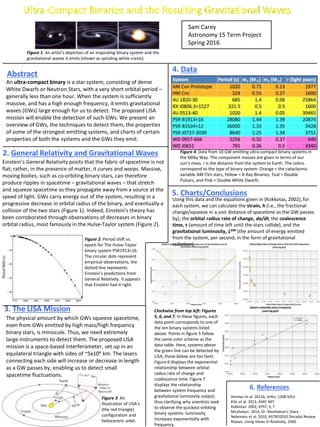
Term Project Poster
- 1. Ultra-Compact Binaries and the Resulting Gravitational Waves Sam Carey Astronomy 15 Term Project Spring 2016 An ultra-compact binary is a star system, consisting of dense White Dwarfs or Neutron Stars, with a very short orbital period – generally less than one hour. When the system is sufficiently massive, and has a high enough frequency, it emits gravitational waves (GWs) large enough for us to detect. The proposed LISA mission will enable the detection of such GWs. We present an overview of GWs, the techniques to detect them, the properties of some of the strongest emitting systems, and charts of certain properties of both the systems and the GWs they emit. Abstract 2. General Relativity and Gravitational Waves Einstein’s General Relativity posits that the fabric of spacetime is not flat; rather, in the presence of matter, it curves and warps. Massive, moving bodies, such as co-orbiting binary stars, can therefore produce ripples in spacetime – gravitational waves – that stretch and squeeze spacetime as they propagate away from a source at the speed of light. GWs carry energy out of the system, resulting in a progressive decrease in orbital radius of the binary, and eventually a collision of the two stars (Figure 1). Indeed, Einstein’s theory has been corroborated through observations of decreases in binary orbital radius, most famously in the Hulse-Taylor system (Figure 2). Figure 1: An artist’s depiction of an inspiraling binary system and the gravitational waves it emits (shown as spiraling white crests). Figure 2: Period shift vs. epoch for The Hulse-Taylor binary system PSR1913+16. The circular dots represent empirical observations, the dotted line represents Einstein’s predictions from General Relativity. It appears that Einstein had it right. 3. The LISA Mission The physical amount by which GWs squeeze spacetime, even from GWs emitted by high mass/high frequency binary stars, is miniscule. Thus, we need extremely large instruments to detect them. The proposed LISA mission is a space-based interferometer, set up in an equilateral triangle with sides of ~5x106 km. The lasers connecting each side will increase or decrease in length as a GW passes by, enabling us to detect small spacetime fluctuations. Figure 3: An illustration of LISA’s (the red triangle) configuration and heliocentric orbit. 4. Data Figure 4: Data from 10 GW emitting ultra-compact binary systems in the Milky Way. The component masses are given in terms of our sun’s mass. r is the distance from the system to Earth. The colors correspond to the type of binary system: Orange = the cataclysmic variable AM CVn stars, Yellow = X-Ray Binaries, Teal = Double Pulsars, and Pink = Double White Dwarfs. 5. Charts/Conclusions Using this data and the equations given in (Kokkotas, 2002), for each system, we can calculate the strain, h (i.e., the fractional change/squeeze in a unit distance of spacetime as the GW passes by), the orbital radius rate of change, da/dt, the coalescence time, τ (amount of time left until the stars collide), and the gravitational luminosity, LGW (the amount of energy emitted from the system, per second, in the form of gravitational radiation). 6. References Clockwise from top left: Figures 5, 6, and 7. In these figures, each data point corresponds to one of the ten binary systems listed above. Points in figure 5 follow the same color scheme as the data table. Here, systems above the green line can be detected by LISA, those below are too faint. Figure 6 displays the exponential relationship between orbital radius rate of change and coalescence time. Figure 7 displays the relationship between system frequency and gravitational luminosity output, thus clarifying why scientists seek to observe the quickest-orbiting binary systems: luminosity increases exponentially with frequency. Hermes et al. 2012b, ArXiv, 1208.5051 Kilic et al. 2013, ASPC 467 Kokkotas. 2002, EPST, 3, 7 Mirshekari. 2014, Dr. Manhattan’s Diary Nelemans et al. 2010, ASTRO2010 Decadal Review Rowan, Living Views In Relativity, 2000